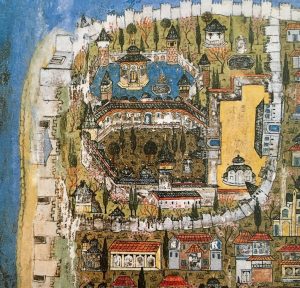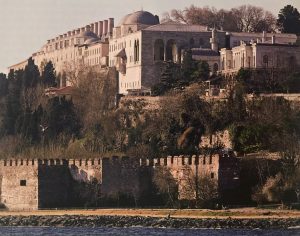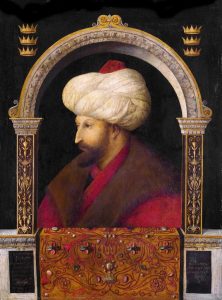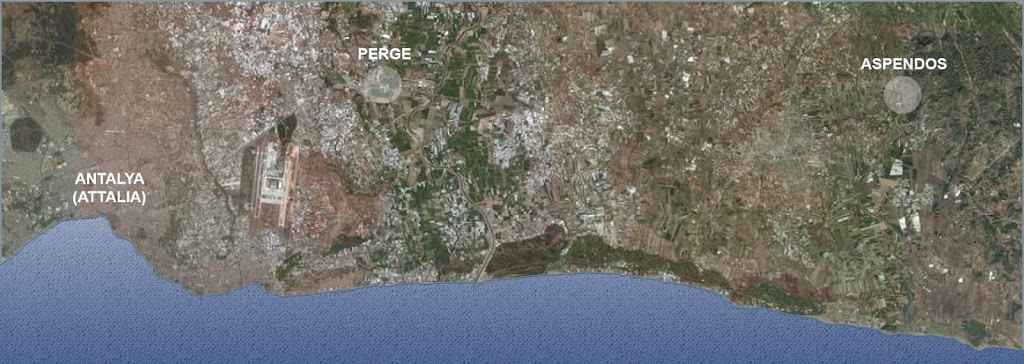
Although architecture is an area close to art, the most different aspect of painting, literature and sculpture is that you have an employer. Rarely, an architect finds the opportunity to produce without an employer or in an environment where the employer offers him unlimited freedom. I’m not saying right or wrong, that’s the nature of this.
When this happens, it is not enough to satisfy you. He has to satisfy his employer, too? This is a matter of deep debate. I’m not so sure about the answer. Regardless, if you can’t satisfy your employer today you probably won’t get another job from the same employer. But in history this can be more risky. Especially if there is dissatisfaction of monarchs with tremendous power…
Fatih Sultan Mehmet is a good example in this regard. Let’s start by denying a city myth, then let’s see a real example of Fatih being a hard-to-appreciate person in terms of architecture.
When it comes to history, often on the Internet, often false or exaggerated content spreads more quickly than reasonable and substantive information. People are more willing to read and spread extreme examples, great tragedies or miracles. The reason why this is so must be the field of socio-psychology. In the field of architecture, this situation is mostly found in the fabricated contents attributed to Mimar Sinan. It is not enough for him to be a good architect for us to appreciate him, or to honor him most of the time. Only then can Sinan satisfy us.
Yaaa, look… We took the architect from his employer’s satisfaction and connected him to the satisfaction of society. Here’s another deep topic.
Anyway, I didn’t extend it, in one of the last articles I mentioned the absurd content that was invented about Mimar Sinan. You can find the link at the end of the article.The subject of this article is Fatih Sultan Mehmet. According to the content circulating on the internet, Fatih is punishing the architect of the complex (Architect Atik Sinan), which he ordered to build right after conquering Istanbul. Some say he cut off his hands, others say his head. There are various rumors about why he punished. Some say that the dome or height of the mosque cannot exceed Hagia Sophia, while others say it shortens the columns of the mosque. In fact, a friend who recently died in the costume of Maras ice cream parlor takes a story that tells the video on the internet. I don’t give you the link, let him watch it up.Evliya Çelebi is the source of this story… Evliya Çelebi talks about this event in her travel book and tells the story of a woman trying Fatih in a fictional court. This story, which seems quite contrary to the realities of the period, cannot be confirmed by any document as I said. Considering that Evliya Çelebi lived some 150 years after Atik Sinan and narrated some rumors or rumors among the people in his travel book, this narrative is likely to be a city legend that has existed since the 17th century.Sometimes it is said that this legend stems from the expression on the tombstone. The tombstone is written in today’s Turkish:” Honored to receive forgiveness from God and the grace of Mimar Sinan, the twenty-seventh day of the first rap month in the 876 years from the mortal world (13 September 1471), after the night of evening prayers Thursday, Friday, was killed in a dark prison in the sea, emigrated to the immortal world. God bless him from the grave and the grief of hell web web (web1)
Although the architect shows that he was punished for a reason, it is hard to say that this is related to Fatih Mosque. Some even argue that this punishment was not an architectural matter, but for embezzlement. Again, there is no document. In summary, there is no evidence, documents etc. that are reliable in this direction. no. Of course, in the case of historical events, it is not always true that there is absolutely no document, but it is not possible for the document of such an important event not to be archived. I think it is disrespectful to remember Architect Atik Sinan like this. However, there is no possibility of disliking the mosque of the complex built by Fatih on his behalf. Because the palace issue I will mention below shows that this friend has a somewhat difficult structure.In the meantime, it should be noted that the Mosque of Fatih Complex is not the original mosque built by Architect Atik Sinan. The original mosque was destroyed in the 1766 earthquake and then rebuilt in a different architecture.
As for the palace issue…
The third and last capital of the Ottoman Empire, Istanbul (Bursa-Edirne-Istanbul, Söğüt, not capital, rather than the center of the principalities) probably has magnificent palaces. In fact, previous cities arouse curiosity about this. For example, how and where was the palace in Bursa? I don’t think there’s any trace of this palace. I need to look at it sometime. I remember that the palace in Edirne was also largely destroyed. Detailed information about this palace is available from Kuban, 2007.
What is interesting is that we could not preserve almost any of the state’s most magnificent structures. It’s worth thinking about.
Anyway, when we come to Istanbul, the situation seems a little better. If we go back from recent history, there are many 19th century palaces which became the residence of the sultans and the administrative center of the state, but especially the Dolmabahçe Palace is still standing. Topkapi Palace, which was the center of the state for 4 centuries before Dolmabahce, still stands as the representative of a different kind of palace structure with its magnificent splendor. Many people think that this palace is the first palace in Istanbul, but even in the Ottoman Empire, but of course not. Of course, the Ottoman Empire had old palaces in Bursa and Edirne. As mentioned above, unfortunately, these palaces have not survived. Was there an Ottoman palace in Istanbul before the Topkapi Palace?
There was, of course.
Where was this “Old Palace” and what did it look like?According to sources, the Forum was built in the Tauri in the Byzantine period.The Forum Tauri (Taurus Forum) is one of the squares on the “Mese çık, the main street of the Byzantine capital, which leads from the palace to the west. Its present location falls between the gate of Istanbul University, Bayezid Mosque and Süleymaniye Complex.
Although the architect shows that he was punished for a reason, it is hard to say that this is related to Fatih Mosque. Some even argue that this punishment was not an architectural matter, but for embezzlement. Again, there is no document. In summary, there is no evidence, documents etc. that are reliable in this direction. no. Of course, in the case of historical events, it is not always true that there is absolutely no document, but it is not possible for the document of such an important event not to be archived. I think it is disrespectful to remember Architect Atik Sinan like this. However, there is no possibility of disliking the mosque of the complex built by Fatih on his behalf. Because the palace issue I will mention below shows that this friend has a somewhat difficult structure.In the meantime, it should be noted that the Mosque of Fatih Complex is not the original mosque built by Architect Atik Sinan. The original mosque was destroyed in the 1766 earthquake and then rebuilt in a different architecture.
As for the palace issue…
The third and last capital of the Ottoman Empire, Istanbul (Bursa-Edirne-Istanbul, Söğüt, not capital, rather than the center of the principalities) probably has magnificent palaces. In fact, previous cities arouse curiosity about this. For example, how and where was the palace in Bursa? I don’t think there’s any trace of this palace. I need to look at it sometime. I remember that the palace in Edirne was also largely destroyed. Detailed information about this palace is available from Kuban, 2007.
What is interesting is that we could not preserve almost any of the state’s most magnificent structures. It’s worth thinking about.
Anyway, when we come to Istanbul, the situation seems a little better. If we go back from recent history, there are many 19th century palaces which became the residence of the sultans and the administrative center of the state, but especially the Dolmabahçe Palace is still standing. Topkapi Palace, which was the center of the state for 4 centuries before Dolmabahce, still stands as the representative of a different kind of palace structure with its magnificent splendor. Many people think that this palace is the first palace in Istanbul, but even in the Ottoman Empire, but of course not. Of course, the Ottoman Empire had old palaces in Bursa and Edirne. As mentioned above, unfortunately, these palaces have not survived. Was there an Ottoman palace in Istanbul before the Topkapi Palace?
There was, of course.
Where was this “Old Palace” and what did it look like?According to sources, the Forum was built in the Tauri in the Byzantine period.The Forum Tauri (Taurus Forum) is one of the squares on the “Mese çık, the main street of the Byzantine capital, which leads from the palace to the west. Its present location falls between the gate of Istanbul University, Bayezid Mosque and Süleymaniye Complex.
| Suleymaniye Complex is seen above and Bayezid Mosque is seen below. The Forum Tauri coincided with the area between these two. |
Doğan Kuban gives the following information about the location and form of the Old Palace:
The Old Palace, kuzeyinde in the north of the old Tauri Forum, is located in a large area including the central buildings of present-day Istanbul University Beyazit and Suleymaniye, the other on the ruins of the former Byzantine and the first Roman city, overlooking the Harbor and the Bosphorus. It is called the Old Palace and some of its elements remained until the Ministry of War was built in the 19th century.
Here, the Istanbul plateau has an elevation overlooking the Marmara and Golden Horn. Tursun Bey, a close man of the Conqueror and the bookkeeper, describes the Old Palace in Fatih’s History as follows:
‘After the new zoning activities, the edict ordered that a new palace was built for his reign and residence. Against Galata, in the lodges of Kostantiniye Castle, Ayyub-el-En-sari overlooks the grave and the pier (Eminönü Port) and Tophane and the entire Golden Horn, and chose an honorable place for land and sea. A sublime palace was built by the ingenious architects and engineers of Arab and Persian and Greek Cypriots, and with the guidance of his own mature mind, he soon built a beautiful and heartfelt office with beautiful works of art. Every pavilion and pavilion is a heartfelt recipient, and the serenity of the river and the river Kevser will be from there. He had a fortification in this magnificent palace that gave the heart some relief. He built a beautiful castle with triangular and circle towers and dervishes and gates in Turkic and Syphilis style. Between the castle wall and the palace wall, vineyard, garden, garden and rose. It is decorated with fountains, pools and chat stalls. ‘ There is almost no data from this palaceK (Kuban, 2007).
Halil İnalcık gives the translation of Tursun Beg and claims that this palace is the tiled kiosk that is standing today in the last sentence.
Haydaaa… Things got confused.
Translation of İnalcık:
” Decided to build a new palace should reign-du After these reserves. Bringing master architects and engineers from Arab, Persian and Greek to build this palace in a place facing the land and sea to Eyüp graveyard, pier, tophane and harbor to the end of Constantinople fortress, he brought “within a short time with the guidance of self-minded architecture”. palace Neither Iran nor Byzantine registers saw this palace. He had a fortification around the palace. Fucked a castle. Between the fortification of the castle wall and the palace wall and garden and garden and rose. There are fountains and pools and meeting places. He built a ça glazed palace içinde in the style of the former Iranian rulers in the garden (Tiled Pavilion) ”(İnalcık, 2019).
The fact that Sırça Saray is in Iranian style and that today’s Tiled Kiosk is close to Iranian style makes this pairing reliable.
So Kuban is wrong, the description of the palace in Tursun Beg fits the Topkapi Palace.

Raki The Old Palace ünde in a miniature of Matraki Nasuh (Kuban, 2007).
Kuban calls it the Old Palace, but I don’t know exactly what you mean.
The structures in the visual looks to me like Topkapi Palace. Especially the city walls and gates.
In fact, when we look at the map of İnalcık below, it is understood that Matraki’s place cannot be the Old Palace.
It appears that both the location and construction dates of the Old Palace and Topkapi Palace are very close to each other. Then why would two new palaces of the same function be built almost in succession to the conquered new capital?
Hah, this is where the conqueror’s conquest is revealed.
Doğan Kuban says that Fatih initiated the construction of two palaces – that is, both the Old Palace and the Topkapı Palace. That sounds kind of weird. Why would one start two palaces? Perhaps he did not think of either of them as a palace, but of different functions. Was he going to disrupt the functions of the palace, or did he think of someone as a dwelling and a management center? I was obviously not sure of this “startup at the same time” job. In another place, Kuban describes the process as follows:
” After the conquest of Istanbul Fatih delayed arrival, the first time in 1455 and settled in the Old Palace. The construction of the New Palace (Saray-ı Hümayun), which would later be called Topkapı Palace, began after 1455. At that time, “Kal’a-i Sultani” was called the name. This palace was built on the area occupied by the ancient Greek city of Bizantion. The site plan determined by Fatih consisted of three courtyards and an outside garden within the 700-acre area . K (Kuban, 2007).
From this narrative, it seems as if the Old Palace was built quickly between 1453-55 and the construction of Topkapı Palace started in 1455 after it was settled here. That’s weird. Didn’t he like Fatih Old Palace?
Neşri gives the answer to this question… Yes, he didn’t like it. In Neşri History, the event is explained as follows:
“The Old Palace (the University in Bayezid Square today) was turned into a hârem before the construction, pushed the tavattun at the moment , then did not like the land, even a land yapırıb hârem idib in the ali palaces yabup moment taht-gah was idol, who was almost unbelievers in the time Zeytunluk dirlerdi was perfect at the moment İn (İnalcık, 2019).
Inalcik, meanwhile, stated in the footnote that Neşri also transferred this part from Aşıkpaşazade.

| Topkapi Palace, view from the sea. Photo by Cemal Emden (Kuban, 2007) |
Yeah. I think we can summarize it now:Fatih, immediately after taking Istanbul ordered a palace to be built. The area between the famous gate of today’s Istanbul University and the Süleymaniye Complex is designated as a palace and surrounded by walls. However, Fatih does not like the palace built here and another palace in Sarayburnu, where he lives and governs the state. The old palace is also the residence of the sultans and other relatives of the old sultans, who are generally unwanted to be seen in Topkapı Palace during the period of his standing.Meanwhile, there is no information about the first architects of both palaces. The architect of the Old Palace was probably not praised or appreciated, but his hands, feet and head probably continued his life. Perhaps the construction of the Topkapi Palace may have been given to him. After all, the man experienced in palace architecture… Lastly, ne How long have you told Fatih’s compassion, how did he not like our miniaturists and brought a painter from Italy?… You’re right.

| The sultan, who had his portrait in the western style first, was Fatih Sultan Mehmet. (web3) Gentile Bellini, a prominent Italian painter, came to Istanbul in 1479, where he painted the portrait of Sultan Mehmet the Conqueror during his two years there. This is actually a very, very important issue, but let it be another article artık |
On the false attribution attributed to Mimar Sinan:https://arkeogezi.blogspot.com/2018/07/mimar-sinann-cizmedigi-mimar-sinan.html


